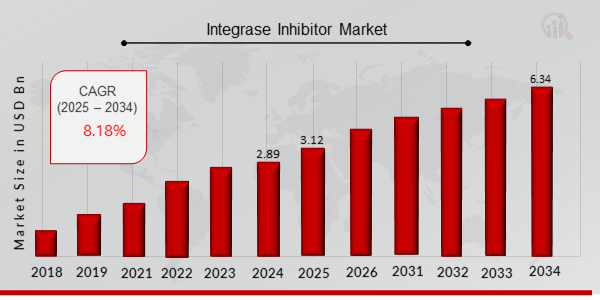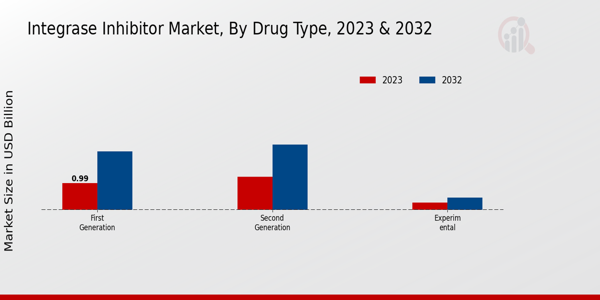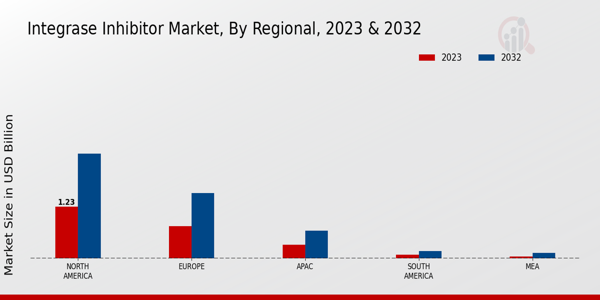Integrase Inhibitor Market Overview
As per MRFR analysis, the Integrase Inhibitor Market Size was estimated at 2.89 (USD Billion) in 2024. The Integrase Inhibitor Market Industry is expected to grow from 3.12 (USD Billion) in 2025 to 6.34 (USD Billion) till 2034, at a CAGR (growth rate) is expected to be around 8.18% during the forecast period (2025 - 2034).
Key Integrase Inhibitor Market Trends Highlighted
The Integrase Inhibitor Market is witnessing significant growth driven by the increasing prevalence of HIV globally. This rise is attributed to better awareness, improved testing methods, and advancements in treatment options. As healthcare systems evolve, more patients have access to antiretroviral therapies, and integrase inhibitors are becoming a preferred treatment due to their effectiveness and lower side effects. The push for innovative therapies and personalized medicine is also shaping the market dynamics, leading to more refined treatment regimens that improve patient compliance and health outcomes. Opportunities abound for pharmaceutical companies in the development of next-generation integrase inhibitors.There is a demand for drugs that not only improve efficacy but also address issues like drug resistance and treatment adherence. As new research continues to emerge, companies have the chance to explore combination therapies that can enhance the overall treatment landscape. Additionally, expansion into emerging markets presents a valuable opportunity, as these regions are beginning to establish more robust healthcare infrastructures and better access to treatment. Recent trends indicate a significant shift towards long-acting formulations and fixed-dose combinations in the integrase inhibitor market. These advancements are designed to improve patient convenience and adherence by reducing the frequency of dosing.The market also reflects a growing interest in the use of integrase inhibitors in pre-exposure prophylaxis (PrEP) strategies, further highlighting their evolving role in comprehensive HIV prevention and treatment strategies. As healthcare providers continue to seek efficient and patient-friendly treatment options, the overall landscape for integrase inhibitors appears strong and promising.

Source: Primary Research, Secondary Research, MRFR Database and Analyst Review
Integrase Inhibitor Market Drivers
Increasing Incidence of HIV Infections
The rise in the global incidence of HIV infections is one of the most significant drivers propelling the Integrase Inhibitor Market Industry forward. With millions of people worldwide currently living with HIV/AIDS, there is an urgent need for effective antiretroviral therapies. The emergence of integrase inhibitors as a pivotal class of antiretroviral drugs has transformed the management of HIV, offering patients improved outcomes and better quality of life.These drugs play a critical role in the treatment regimen, effectively reducing viral load and enhancing immune function. The need for ongoing treatment and adherence to medication regimens in the face of rising infection rates fuels ongoing demand for integrase inhibitors. Additionally, the global healthcare systems are increasingly recognizing the importance of early diagnosis and treatment, further driving investment and research into innovative therapies, including integrase inhibitors.As healthcare providers expand access to these treatments, more patients will be able to benefit, which in turn is poised to bolster market growth significantly in the coming years.
Advancements in Drug Development
Innovative advancements in drug development have led to the creation of new and more effective integrase inhibitors, significantly contributing to the growth of the Integrase Inhibitor Market Industry. The ongoing research and development efforts by pharmaceutical companies are focused on improving the safety and efficacy profiles of these drugs, reducing side effects, and enhancing patient compliance. The launch of novel compounds with improved dosing regimens makes treatment more convenient for patients, which is crucial for maintaining adherence.As the market sees continuous updates with state-of-the-art medications resulting from these advancements, it attracts not only a growing number of patients but also healthcare professionals who are keen on prescribing the latest effective medicines. The evolution of these treatments ensures that the Integrase Inhibitor Market continues to thrive as healthcare providers constantly seek effective solutions in HIV management.
Increased Awareness and Screening Programs
The growing awareness of HIV prevention and treatment among the global population has significantly propelled the Integrase Inhibitor Market Industry. As educational and awareness campaigns increase, the public is becoming more informed about the importance of early detection and treatment of HIV. Screening programs supported by governmental health organizations and non-profits have made testing more accessible, leading to increased diagnosis rates.Consequently, with more individuals aware of their HIV status and in need of effective treatment options, the demand for integrase inhibitors has risen. The push for routine screening in high-risk populations and the normalization of HIV treatment enables healthcare providers to advocate for integrase inhibitor therapies, resulting in enhanced market potential in the upcoming years.
Integrase Inhibitor Market Segment Insights
Integrase Inhibitor Market Drug Type Insights
The Integrase Inhibitor Market, focused on the Drug Type segment, is showcasing a robust growth trajectory, reflecting an increasing demand for innovative therapeutics in the treatment of HIV and other viral infections. In 2023, the overall market is valued at 2.47 USD Billion, with expectations to reach 5.0 USD Billion by 2032, demonstrating a strong expansion in this critical sector of the healthcare industry. Among the various categories, the first-generation drugs represent a significant share of the revenue, accounting for 0.99 USD Billion in 2023 and forecasted to grow to 2.15 USD Billion by 2032. This growth is driven by the established effectiveness of first-generation therapies, which have been instrumental in managing HIV viral loads effectively, thereby contributing to their dominance in this market segment.The Second Generation category also holds a significant position in the market, with a valuation of 1.22 USD Billion in 2023, anticipated to increase to 2.4 USD Billion by 2032. This segment is marked by advancements in drug efficacy and safety profiles, addressing the limitations of earlier treatments and catering to the evolving needs of patients. The introduction of drugs in this category exemplifies the industry's commitment to innovation, leading to improved patient adherence and outcomes.
Additionally, the Experimental categories, valued at 0.26 USD Billion in 2023 and expected to grow to 0.45 USD Billion by 2032, while smaller in comparison, represent the ongoing research and development efforts in the Integrase Inhibitor field. This reflects a focus on discovering novel therapeutic options that can potentially offer enhanced treatment capabilities and lower resistance risks.Market dynamics, including the rise in HIV prevalence and a growing awareness of treatment options, are propelling the growth of drug types within the Integrase Inhibitor Market. The majority holding of First Generation drugs underscores their long-standing importance, while the substantial growth trajectories of Second Generation and Experimental drugs indicate a vibrant pipeline of innovative therapies set to advance patient care.
As the market adapts to new challenges, these dynamics contribute to the overall Integrase Inhibitor Market revenue and significantly shape the Integrase Inhibitor Market statistics. The ongoing research efforts into Experimental drugs showcase potential opportunities for further market development and diversification, enabling a comprehensive approach to managing HIV and related viral infections across different patient populations and enhancing the landscape of treatment options available in the Integrase Inhibitor Market industry.

Source: Primary Research, Secondary Research, MRFR Database and Analyst Review
Integrase Inhibitor Market Administration Route Insights
The Integrase Inhibitor Market, valued at 2.47 USD Billion in 2023, showcases a diverse landscape, particularly concerning the Administration Route. This segment comprises various methods, with emphasis on Oral, Intravenous, and Subcutaneous routes for drug delivery. Oral administration is particularly significant due to its ease of use and patient compliance, making it a popular choice among healthcare providers and patients. The Intravenous route, on the other hand, is crucial when immediate effects are required and is often utilized in hospital settings.Subcutaneous delivery also plays an important role, especially for long-acting formulations, which can enhance therapeutic outcomes. Market trends indicate consistent growth driven by increasing incidences of chronic diseases and an expanding patient population, positioning the Integrase Inhibitor Market for robust performance. While opportunities abound in novel drug formulations and technological advancements in delivery systems, challenges such as stringent regulatory frameworks and competition from alternative therapies remain prevalent in the market landscape.The projected growth trajectory indicates that by 2032, the market's potential will reach a valuation of 5.0 USD Billion, with a noteworthy CAGR of 8.18 from 2024 to 2032, demonstrating the healthy demand for integrase inhibitors in various administration routes.
Integrase Inhibitor Market Therapeutic Area Insights
The Integrase Inhibitor Market within the Therapeutic Area segment is a crucial component standing at a valuation of 2.47 USD Billion in 2023, forecasted to reach 5.0 USD Billion by 2032, reflecting a steady market growth trend. This segment encompasses various conditions, notably HIV Infection, HCV Infection, and Other Viral Infections. The significance of HIV Infection dominates this sector, primarily due to the rising prevalence of HIV globally and the essential role of integrase inhibitors in the treatment regimen. HCV Infection is also noteworthy, as advancements in treatment efficacy and patient adherence are driving interest and investment in this area, fostering a competitive landscape.Other Viral Infections, while a smaller segment, showcase the versatility of integrase inhibitors beyond HIV and HCV, thus contributing to the overall market dynamics. The Integrase Inhibitor Market data indicates that increasing healthcare expenditure, a rise in viral infection cases, and technological advancements are key growth drivers. However, challenges such as drug resistance and stringent regulatory requirements may impact market development. The Integrase Inhibitor Market statistics illustrate a promising outlook driven by these trends and a focus on innovation within the industry.
Integrase Inhibitor Market Sales Channel Insights
The Sales Channel segment of the Integrase Inhibitor Market plays a crucial role in its expansion and accessibility. In 2023, the overall market revenue reached 2.47 USD Billion, reflecting the growing demand for integrase inhibitors across various distribution channels. Hospital Pharmacies have emerged as a critical access point, providing direct services to patients receiving treatment within medical facilities. Meanwhile, Retail Pharmacies offer convenience and a more personal approach for patients, ensuring that medications are available locally.The rise of Online Pharmacies is transforming the landscape, allowing for greater accessibility and convenience for patients who prefer purchasing medications from the comfort of their homes. As the Integrase Inhibitor Market data indicates, these channels collectively contribute significantly to market growth, driven by increasing awareness and rising healthcare needs. Market trends show that the increasing preference for home delivery services enhances the importance of Online Pharmacies. Overall, the market statistics underline the diversity in sales channels that cater to a wide range of consumer preferences, highlighting the opportunities and challenges present in this evolving landscape.
Integrase Inhibitor Market Regional Insights
The Integrase Inhibitor Market exhibits a diverse regional segmentation, with North America leading the market, valued at 1.23 USD Billion in 2023, and anticipated to rise to 2.48 USD Billion by 2032, showcasing its majority holding in market revenue. Europe follows with a significant valuation of 0.77 USD Billion in 2023, expected to double to 1.55 USD Billion in 2032, underscoring its strong demand for integrase inhibitors. In the APAC region, the market was valued at 0.33 USD Billion in 2023, with a projection to reach 0.66 USD Billion by 2032, reflecting steady growth from rising healthcare investments.South America and MEA, however, hold smaller shares, with valuations of 0.09 USD Billion and 0.05 USD Billion in 2023, respectively, showing potential for growth but currently remain less dominant in the Integrase Inhibitor Market. The increasing prevalence of HIV and rising awareness about integrase inhibitors globally are key drivers for market growth, while challenges such as pricing pressures and regulatory hurdles may impact future expansion. The data reflects a robust opportunity for growth, particularly in the North American and European markets, which dominate the Integrase Inhibitor Market statistics through effective market strategies and advancements in therapeutic solutions.

Source: Primary Research, Secondary Research, MRFR Database and Analyst Review
Integrase Inhibitor Market Key Players and Competitive Insights
The Integrase Inhibitor Market is a dynamic segment within the larger framework of antiviral therapeutics, particularly focusing on the treatment of human immunodeficiency virus (HIV). The competitive landscape is characterized by a mix of established players and emerging companies striving to innovate and enhance treatment options for patients. Given the increasing prevalence of HIV globally and the ongoing research and development efforts, integrase inhibitors have gained significant traction. This sector is driven by advancements in technology, changes in regulatory frameworks, and the increasing demand for highly effective treatments with fewer side effects. Industry participants are also competing on the basis of market share, pricing strategies, and therapeutic efficacy, which adds a layer of complexity to the market dynamics.Janssen Pharmaceuticals holds a strong position in the Integrase Inhibitor Market, leveraging its robust research and development capabilities to advance its product offerings. With a well-established portfolio of integrase inhibitors, the company has successfully carved a niche for itself in addressing the evolving needs of the HIV treatment landscape. One of the key strengths of Janssen Pharmaceuticals lies in its commitment to innovation, with continuous investments in clinical trials and studies that enhance the therapeutic profile of its medications. The firm also benefits from a strong distribution network and strategic partnerships that allow it to maintain a competitive edge in accessing various markets. Its strong brand reputation among healthcare providers and patients further underscores its market presence, making it a significant player in the realm of integrase inhibitors.Teva Pharmaceutical Industries is another pivotal player in the Integrase Inhibitor Market, recognized for its extensive expertise in pharmaceutical development and manufacturing. The company has positioned itself effectively by tapping into the growing demand for high-quality, affordable treatments for HIV. Teva's strengths include a diverse product pipeline and a global reach that facilitates the distribution of its integrase inhibitors across multiple regions. Through strategic alliances and collaborations, the company has amplified its research efforts, thereby enhancing its capability to bring innovative solutions to market. Teva is also known for its adaptability to market trends, allowing it to respond rapidly to evolving healthcare needs and regulations. With a focus on maintaining cost-effectiveness while ensuring high standards of quality, Teva Pharmaceutical Industries remains a formidable competitor in the integrase inhibitor landscape.
Key Companies in the Integrase Inhibitor Market Include
- Janssen Pharmaceuticals
- Teva Pharmaceutical Industries
- Mylan
- Bristol Myers Squibb
- Hepalink
- HoffmannLa Roche
- AstraZeneca
- Gilead Sciences
- Aurobindo Pharma
- AbbVie
- Zydus Cadila
- Reddy's Laboratories
- Merck and Co
- ViiV Healthcare
- Sanofi
Integrase Inhibitor Market Industry Developments
The Integrase Inhibitor Market has witnessed several noteworthy developments recently, particularly with advancements in drug formulations and market approvals. Companies such as Gilead Sciences and Merck & Co have been involved in enhancing their product offerings with new formulations aimed at improving patient adherence and therapeutic effectiveness. Increased collaboration between pharmaceutical companies, including strategic partnerships involving Janssen Pharmaceuticals and ViiV Healthcare, signifies a growing trend in the market towards innovation and shared expertise. Additionally, the rise in demand for integrase inhibitors, due to the increasing prevalence of HIV globally has spurred competition among key players such as Bristol Myers Squibb and Teva Pharmaceutical Industries. On the merger and acquisition front, there have been movements with firms like AbbVie exploring opportunities for expansion and increased market share within the integrase inhibitor space, reflecting strategic alignment with evolving market dynamics. The overall market valuation for these companies is trending positively, driven by ongoing research and development activities, regulatory approvals, and an expanding patient base reliant on these crucial therapies, ultimately impacting the landscape of antiviral treatment options.
- Integrase Inhibitor Market Segmentation Insights
- Integrase Inhibitor Market Drug Type Outlook
- First Generation
- Second Generation
- Experimental
- Integrase Inhibitor Market Administration Route Outlook
- Oral
- Intravenous
- Subcutaneous
- Integrase Inhibitor Market Therapeutic Area Outlook
- HIV Infection
- HCV Infection
- Other Viral Infections
- Integrase Inhibitor Market Sales Channel Outlook
- Hospital Pharmacies
- Retail Pharmacies
- Online Pharmacies
| Report Attribute/Metric |
Details |
|
Market Size 2024
|
2.89 (USD Billion)
|
|
Market Size 2025
|
3.12 (USD Billion)
|
|
Market Size 2034
|
6.34 (USD Billion)
|
|
Compound Annual Growth Rate (CAGR)
|
8.18 % (2025 - 2034)
|
|
Report Coverage
|
Revenue Forecast, Competitive Landscape, Growth Factors, and Trends
|
|
Base Year
|
2024
|
|
Market Forecast Period
|
2025 - 2034
|
|
Historical Data
|
2020 - 2024
|
| Market Forecast Units |
USD Billion |
| Key Companies Profiled |
Janssen Pharmaceuticals, Teva Pharmaceutical Industries, Mylan, Bristol Myers Squibb, Hepalink, HoffmannLa Roche, AstraZeneca, Gilead Sciences, Aurobindo Pharma, AbbVie, Zydus Cadila, Dr. Reddy's Laboratories, Merck and Co, ViiV Healthcare, Sanofi |
| Segments Covered |
Drug Type, Administration Route, Therapeutic Area, Sales Channel, Regional |
| Key Market Opportunities |
Increased prevalence of HIV infections, Growing demand for combination therapies, Rising investment in HIV research, Expansion in developing regions, Advances in drug delivery systems |
| Key Market Dynamics |
Increasing HIV prevalence, Rising demand for effective treatments, Growing awareness of integrase inhibitors, Ongoing R investments, Patent expirations and generic competition |
| Countries Covered |
North America, Europe, APAC, South America, MEA |
Frequently Asked Questions (FAQ) :
The Integrase Inhibitor Market is expected to be valued at 6.34 USD Billion by 2034 .
The anticipated CAGR for the Integrase Inhibitor Market from 2025 to 2034 is 8.18%.
North America is projected to dominate the Integrase Inhibitor Market, expected to reach 2.48 USD Billion by 2032.
The market value for First Generation Integrase Inhibitors is expected to be 2.15 USD Billion by 2032.
The market value for Second Generation Integrase Inhibitors is anticipated to reach 2.4 USD Billion by 2032.
The APAC region's market growth is expected to reach a total value of 0.66 USD Billion by 2032.
Major players in the Integrase Inhibitor Market include Janssen Pharmaceuticals, Gilead Sciences, and Bristol Myers Squibb.
The market size for Experimental Integrase Inhibitors is projected to reach 0.45 USD Billion by 2032.
The European Integrase Inhibitor Market is expected to grow to 1.55 USD Billion by 2032.
Key growth drivers for the Integrase Inhibitor Market include the increasing prevalence of HIV and ongoing research and development efforts.

















